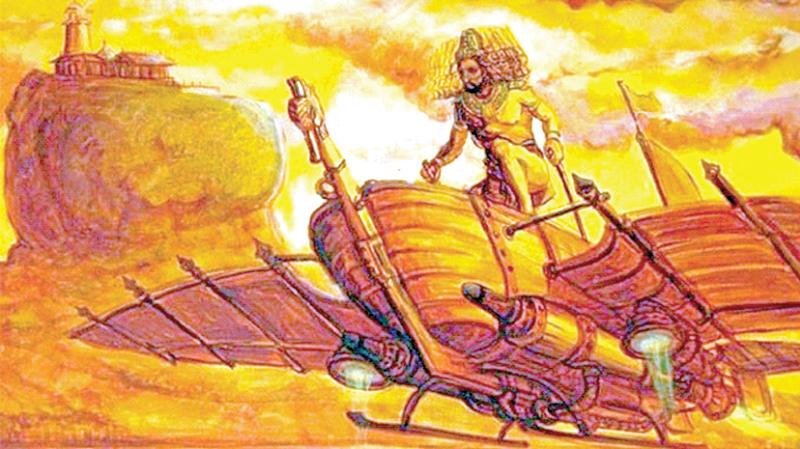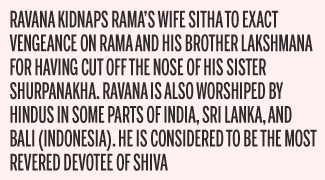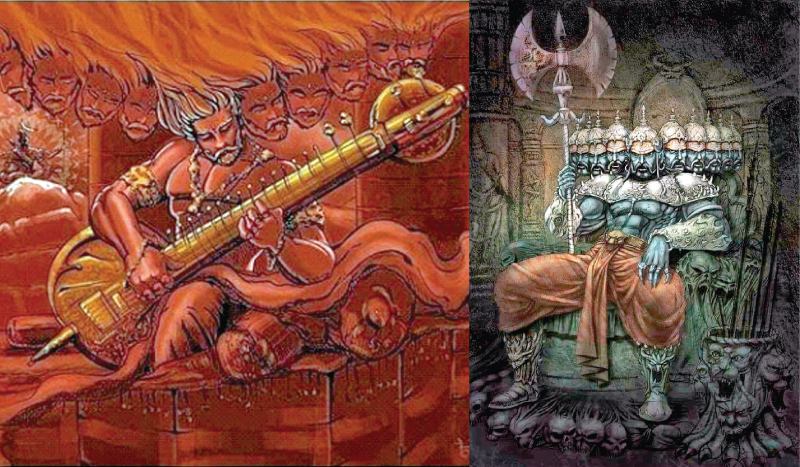
It is impossible to hide the incidents of the past. The past cannot be buried, even though those cultural facts were hidden by the epics or main culture. It is a certain condition that they arise again. Folklore is the main reason for that.
When focusing on Sri Lanka, Rawana is a concept that has been neglected by the hands of archaeology and history of the major cultures. But, the information which is found from Sri Lankan minor culture, India, Germany, and other countries with regard to this concept is contrasted with the information given by the major culture. “Rawana is the main antagonist in the Hindu epic Ramayana, where he is depicted as the Rakshasa (demon) king of Lanka. Rawana is depicted and described as having ten heads and as being a follower of Shiva, a great scholar, a capable ruler, and a maestro of the veena, but someone who wished to overpower the devas.
His ten heads represent his knowledge of the six shastras and the four Vedas. Kandedevi, Laggal Bandaradevi, Kanda devi, Uwamahamahipathi, Dandumonaradivya kumara, Ishwara raja, Buddhiishwaramaha Ravana, Kuda Ravana, Yaksha Ravana, Deva Ravana, Malayarata Ravana, Alle Ravana, and other names were given to him.
Vengeance
In the Ramayana, Ravana kidnaps Rama’s wife Sitha to exact vengeance on Rama and his brother Lakshmana for having cut off the nose of his sister Shurpanakha. Ravana is also worshiped by Hindus in some parts of India, Sri Lanka, and Bali (Indonesia). He is considered to be the most revered devotee of Shiva.
 Images of Ravana are seen associated with Shiva in some places. He also appears in the Buddhist Mahayana text Lakāvatāra Sūtra.” Although it has not been mentioned in the Chronicles directly, there is evidence to prove that a number of myths related to King Ravana was in the rural folklore of Sri Lanka.
Images of Ravana are seen associated with Shiva in some places. He also appears in the Buddhist Mahayana text Lakāvatāra Sūtra.” Although it has not been mentioned in the Chronicles directly, there is evidence to prove that a number of myths related to King Ravana was in the rural folklore of Sri Lanka.
The concept of Ravana (Dasis), or the man who has ten heads, was emerging through the historical legends from Sri Lanka, India, and other South Asian countries. It is not possible for an ordinary man to have ten heads and 20 hands. It has been stated in the epic of Ramayana that Maharavana had ten heads. “Rawana has many other popular names too, such as Dasis Ravana, Dasis Sakvithi Maha Ravana, Dashanan, Ravula, Lankeshwar, Lankeshwaran, Ravanaeshwaran, Eela Vedhar.”
After the decline of the Rakshasa kingdom, the ten fields which Rawana introduced were used as industries by the tribes who worshipped Yaksha and Naga. Those ten skills can be mentioned as: Mathematics and language, law and politics, architecture and city planning, philosophy and knowledge of the soul, technical knowledge of physics, esotericism and juggling knowledge, arts, Sri Lankan traditional medicine (Hela wedakama), astrology and fighting skills and battle techniques.
The facts regarding the ten fields, which are mentioned here, were researched by folklore researcher, Darshana Somarathne, who is a senior lecturer at the University of Kelaniya.
Battle tricks
Vibhishana, King Ravana’s brother, betrayed him in the battle of Rama and Ravana, exposing Ravana’s battle tricks to King Rama to defeate his brother. With this incident, King Ravana became dissatisfied and began a sage life, researching medical science and writing medical books at the monastery. Arkaprakasha, Nadiprakasha, Kumaratantra, Udisatantra, Agnitantra, Agnimalatantra, and Vaimanikatantra are the books that he has written.
King Ravana was one of the best fighters in Angampora, the traditional martial arts of ancient Sri Lanka. He was a great scholar in Ayurvedic medicine. He was the person who invented Arka Shastra. The book Arka Prakshaya reveals this truth to the present world. He wrote several books revealing the cures for many diseases as a result of his willingness to research Ayurvedic medicine.
In one book, he stated that “eating beef causes to infect 98 new diseases in human beings”. The book “Kumara Tantraya”, which reveals the treatments for infant diseases, was written by him at the request of his pregnant queen, Mandodari. King Ravana invented the bow for the violin. He also narrated the very first Raagas, the musical compositions of Eastern classical music known as Lanka Dehena. Shiva Thandawa is one of the great devotional compositions made by him, which is still being used in India.
The most interesting thing in this era was his Dandumonaraya. He was the first king to fly over the world with his aeroplane, known as Dandumonaraya (Shakuna Vimaana). Some evidence of Dandumonaraya, the aeroplane, is found in rock inscriptions, Jataka stories, and Ola manuscripts. From this invention, we can get an understanding of our past technology. All of this highlights that our ancients were rich in high technology and super power.
Nature lover
The Sinhalese folk stories are enriched with Ravana stories. He was continuing a vegan-oriented lifestyle and was a nature lover. According to the Lankavatarasutta, he was a Buddhist and worshipped Kashyapa Buddha.
Once, he invited Kashyapa Buddha to visit Sri Lanka and deliver his sermon to Sri Lankan citizens who practise yoga and follow Buddhism. King Ravana was one of the best emperors in Sri Lankan history. There are more than 300 Sinhala village names related to the King Ravana era. There are some more places in which the Rama-Ravana war took place in Sri Lanka.
As a result of a meteor shower or the disaster caused by the battle of Rama and Ravana, the ancient Hela Rakshasa civilisation has been buried under the earth. The fire that broke out there caused many countries to burn, while others have sunk into the ocean forever.
The Yaksha and Naga tribes, who survived on the hills in the following era, revered their ancient leaders and their abilities, referring to them as Gods. This was the time Gautama Buddha arrived in Sri Lanka (6th century B.C.). That was the Yaksha and Naga tribes’ era, which arose from the ancient civilisation, although it was not as skillful and developed as the Ravana era.
Strength
Referring to ancient theism beliefs, it can be seen that a lot of hands and legs have been added to God’s figure to represent their strength. It is a special fact in Asian countries when they create the Gods that leaders and relatives who died on behalf of the land, who did a great service for many, were treated, offered, and venerated as Gods after their death.
Their power, strength, and abilities were represented in exaggerated ways by special physique. Therefore, several body parts have been added beyond the general human body to show the power of those Gods or Yakshas. This is the way several hands and faces connect into a figure.
Whenever there was a special process or special person in society, after his period, people might think that the process or skills of that person should be preserved by them for their future generation. Therefore, when they preserved it, they had to attribute exaggerated and para-physical facts. Those values exist in their legends in various ways, developed with superhuman (God) status, special names, and symbols.
After the decline of the Ravana kingdom, the Yaksha and Naga tribes continued to use and preserve that knowledge as their traditional heritage. The vast knowledge possessed by the Yaksha and Naga tribes about various industries enabled them to create their own representation of Rakshasa king Ravana as an immortal concept. Divinity or exaggeration has been attributed to show their veneration and for the safety of the tradition.
Ten-headed man
The Dasis concept can be introduced as one reflection of that exaggeration. He was represented in various legends in various ways as a ten-headed man (Dasha Shirshapathi and Dasis). The eternal knowledge of the universe was gathered and maintained by the Yaksha and Naga tribes within the concept of Dasis Ravana.
We have a rich past and today we are out of it. The reason for this is our people. It is hard to imagine a technology like the one in ancient Sri Lanka having existed anywhere else in the world.
Ancient Ceylon was rich in people with technology, literature, arts, and creativity. The country had a wealth of human resources as well as residual resources that could stand as a nation. People had assets that we could feed on without dependence on anyone. We lived as such a country, and now the entire country is bankrupt.
People are accustomed to living on what someone else gives them. Instead of saying no to everything, they are not interested in finding alternatives to what is missing.
People are not trying to find an alternative to the current crisis in the country. No one is interested in finding a way out of problems except to keep vehicles in the oil queues, gas queues and fulfil only their needs. In our country today, people are too lazy to look for alternatives to current issues. If the technology of the past were used today, we would not have to suffer so much today.

